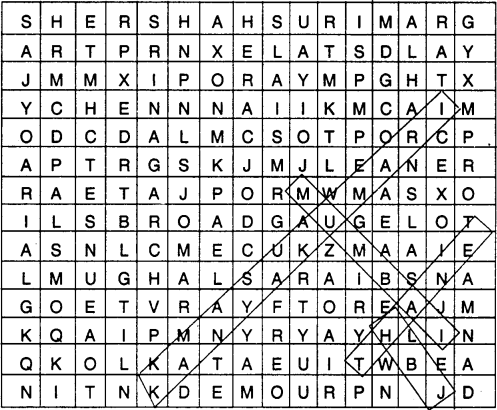1. Multiple choice questions.
1. Which two of the following extreme locations are connected by the east-west
corridor?
(a) Mumbai and Nagpur
(b) Mumbai and Kolkata
(c) Silcher and
Porbandar
(d) Nagpur and Siligudi
Answer:
(c) Silcher and Porbandar
2. Which mode of transportation reduces trans-shipment losses and delays?
(a) Railways
(b) Pipeline
(c) Roadways
(d) Waterways
Answer:
(b) Pipeline
3. Which one of the following is not connected with the H.V.J. Pipeline?
(a) Madhya Pradesh
(b) Gujarat
(c) Maharashtra
(d) Uttar Pradesh
Answer:
(c) Maharashtra
4. Which one of the following ports is the deepest land-locked and
well-protected port along the east coast?
(a) Chennai
(b) Tuticorin
(c) Paradip
(d) Vishakhapatnam
Answer:
(d) Vishakhapatnam
5. Which one of the following is the most important modes of transportation in
India?
(a) Pipeline
(b) Roadways
(c) Railways
(d) Airways
Answer:
(d) Airways
6. Which one of the following terms is used to describe trade between two or
more countries?
(a) Internal trade
(b) Extenal trade
(c) International
trade
(d) Local trade
Answer:
(c) International trade
2. Answer the following questions in about 30 words.
Question 1.
State any three merits of
roadways.
Answer:
1. As compared to railways, construction cost of roadways is lower;
2. Roadways provide door-to-door service;
3. These are used as feeder to other modes of transportation such as link
between railways, stateline, air and sea ports.
Question 2.
Where and why is the rail
transport the most convenient means of transportation?
Answer:
Railways help conduct activities
like business, sightseeing. It is a great integrating force. The network of
railways is best suited to plain areas where agriculture and industry grow
rapidly due to facilities available by industry it.
Question 3.
What is the significance of the
border roads?
Answer:
Border roads are important strategically. These have helped develop northern
and north-eastern areas. In fact, they have increased accessibility in areas
of difficult terrain, besides the economic development of the these areas.
Question 4.
What is meant by trade? What is
the difference between international and local trade?
Answer:
Trade is the medium through which
goods are bought and sold. Local trade conducted in any area: city, state, and
country. International trade is a trade between one country and other
countries.
3. Answer the following questions in about 120 words.
Question 1.
Why are means of transportation
and communication called the lifelines of nations and its economy?
Answer:
In today’s modern world the means
of transport and communication have no doubt turned as the lifelines of a
country and also of its economy.
The various
forms of transport that are used to carry passengers and goods from one place
to another are called the means of transport. On the other hand communication
means sending messages from one place to another. These are known as the
‘Lifelines’ of a country because of the following reasons-
- They bring the far-flung areas of a country quite closer to each other.
- They carry the greatest number of passengers in longest journeys in lesser time but with greater comforts.
- They carry thousands of tonnes of different commodities from one part of the country to the other and thus avoid much hardships to the people.
- Also in the war times, their importance can hardly be emphasized. They bring the whole country at the back of the armed forces and facilitate the movement of arms, ammunition and other supplies.
- These means of communication and transport also help the Government to maintain law and order.
- These various means have also forged the bonds of national unity in our country by promoting social and cultural contacts between the various people of the country.
Question 2.
Write a note on the changing
nature of the international trade in the last fifteen years.
Answer:
In today’s modern world the means
of transport and communication have no doubt turned as the lifelines of a
country and also of its economy.
The various
forms of transport that are used to carry passengers and goods from one place
to another are called the means of transport. On the other hand communication
means sending messages from one place to another. These are known as the
‘Lifelines’ of a country because of the following reasons-
- They bring the far-flung areas of a country quite closer to each other.
- They carry the greatest number of passengers in longest journeys in lesser time but with greater comforts.
- They carry thousands of tonnes of different commodities from one part of the country to the other and thus avoid much hardships to the people.
- Also in the war times, their importance can hardly be emphasized. They bring the whole country at the back of the armed forces and facilitate the movement of arms, ammunition and other supplies.
- These means of communication and transport also help the Government to maintain law and order.
- These various means have also forged the bonds of national unity in our country by promoting social and cultural contacts between the various people of the country.
Quiz Drive
- Northern terminal of the North-south corridor.
- The name of National Highway No. 2.
- The headquarter of the southern railway zone.
- The rail gauge with a track width of 1.676m
- The southern terminal of the National Highway No. 7.
- A Riverine Port.
- Busiest Railway junction in Northern India.
Answer:
1. Srinagar, Broad Ganga,
Kanyakumari Kolkata, HBJ.
Students take the
help of teacher.
Activity
Start your search vertically, horizontally or diagonally and reach to various
destinations across the country.
Sher Shah Suri Marg, Chennai, Broad Gauge, Mugalsarai, Kolkata, Srinagar, Kanyakumari, Thane, HBJ, Mumbai.